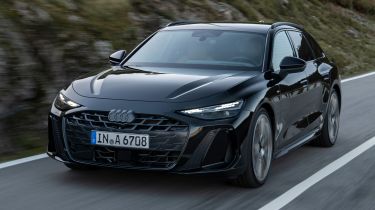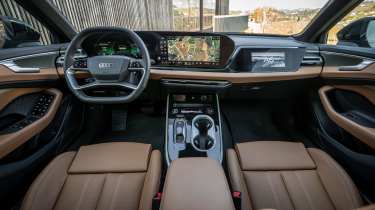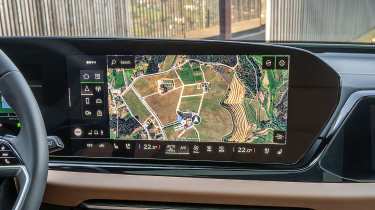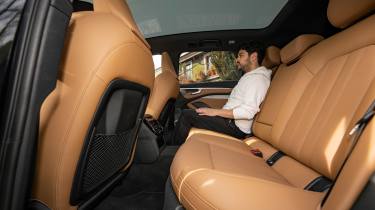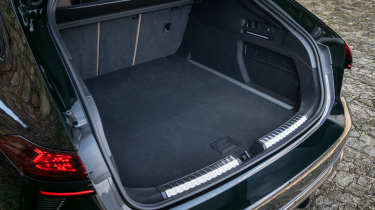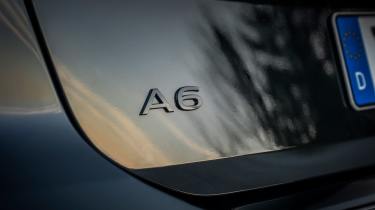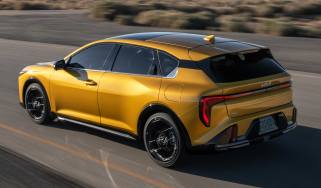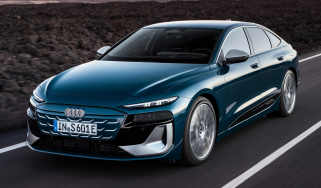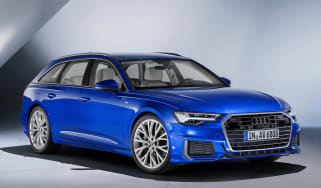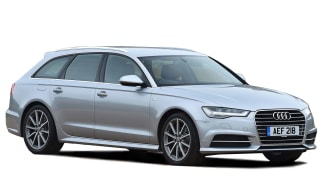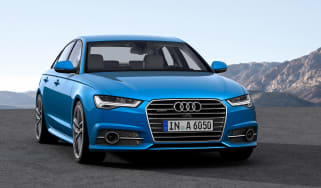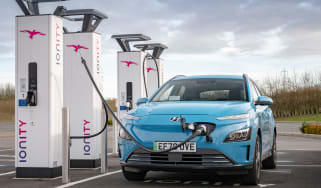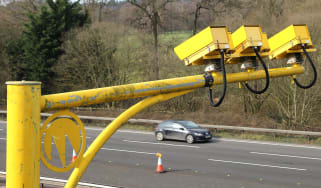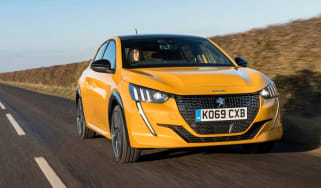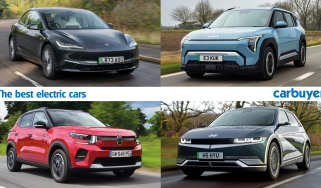Audi A6 Avant review – a style-led premium estate
“The Audi A6 Avant looks the part, but it’s not quite as practical as you’d expect”
Pros
- High-quality interior
- Lots of tech
- Comfortable and refined
Cons
- Infotainment is a bit bewildering
- Boot isn’t as big as rivals
- Petrol and diesel engines aren’t particularly economical
Verdict – is the Audi A6 Avant a good car?
The Audi A6 Avant may sport a very attractive new look, but it’s not a gamechanger compared with the outgoing car. It’s more style-led this time around, and that means it’s not quite as practical as you might expect. It does feel very well built, though and the tech on offer is impressive, while there’s a good balance of driving feel and comfort. The engine range is limited, but this will change when more potent models arrive later down the line.
Audi A6 Avant models, specs and alternatives
The Audi A6 Avant is the estate version of the Audi A6, and this time it’s the first of the nameplate’s body styles to launch, with the saloon following later. In an age where SUVs rule the roost for popularity and practicality, the A6 Avant looks much sleeker, and stands out from the crowd.
While Audi has traditionally taken a very evolutionary approach to its designs with subtle changes to the styling of its cars over time, the latest A6 Avant adopts a stand-out new look. The front end is characterised by thin headlights and large air intakes flanking a large hexagonal grille and is curvier than that of the model that came before it. At the rear the tail-lights are linked on the bootlid via a full-width light bar.
 Best estate cars on sale in 2025
Best estate cars on sale in 2025
As before, the A6 Avant is offered with petrol and diesel power. Both of these engine options are 2.0-litre turbocharged four-cylinders with mild-hybrid assistance. There’s also an electric version, badged the A6 e-tron, which we’ve reviewed separately – confusingly, though, the EV is a completely separate model with distinct underpinnings and so drives and feels very different.
More reviews
The A6 we’re reviewing here was going to be called the A7 under Audi’s plan to give combustion-engined cars badges with odd numbers and its EVs even ones. This naming convention was dropped hastily just before its launch, so the result is two cars under the same A6 badge with very different ingredients.
While not available just yet, plug-in hybrid versions of the A6 are set to arrive later down the line for those that want the benefit of electric power around town and a combustion engine for lengthier trips.
| Trim levels | Power options |
|
|
MPG, running costs & CO2 emissions
| Pros | Cons |
|
|
The latest Audi A6 Avant launches with a simple choice between petrol and diesel power – that is until plug-in hybrid models arrive further down the line. There’s also an all-electric A6 e-tron, but this is, in fact, a completely bespoke model, which is unrelated under the surface. The electric A6 Avant e-tron can do up to 437 miles on a charge, which is rather impressive for an EV, so it’s worth your consideration if you want to make the switch and we’ve reviewed it separately.
The entry-level petrol A6 Avant has a mild-hybrid assisted 2.0-litre turbocharged TFSI engine, and the official fuel economy figures in the high 30s are about what you can expect from similar cars in the class. The TDI diesel is also 2.0 litres in size with turbocharging and mild-hybrid assistance, but with fuel economy in the late 40s, it’s hardly the most impressive diesel executive estate on the market – the Mercedes E220d Estate will do up to 56.5mpg, for example. In fact, these tried-and-tested combustion engines are nothing to write home about in terms of efficiency when fitted into a large, heavy estate car.
The latest Audi A6 Avant launches with a simple choice between petrol and diesel power – that is until plug-in hybrid models arrive later down the line. There’s also an all-electric A6 e-tron, but this is, in fact, a completely bespoke model, which is unrelated under the surface. The electric A6 Avant e-tron can do up to 437 miles on a charge, which is rather impressive for an EV, so it’s worth your consideration if you want to make the switch and we’ve reviewed it separately.
The entry-level petrol A6 Avant is a mild-hybrid assisted 2.0-litre turbocharged TFSI engine, and fuel economy figures in the high 30s are about as good as you can expect. The TDI diesel is also 2.0 litres in size with turbocharging and mild-hybrid assistance, but with fuel economy in the late 40s, it’s hardly the most impressive diesel on the market. In fact, these tried-and-tested combustion engines are nothing to write home about in terms of efficiency when fitted into a large, heavy estate car.
| Model | Fuel economy | CO2 emissions |
| 2.0-litre TFSI petrol | 37.1mpg | 173g/km |
| 2.0-litre TDI diesel | 48.7mpg | 153g/km |
How efficient is the Audi A6 Avant in the real world?
In our experience with the Audi A6 Avant in both petrol and diesel guise, we found the official fuel economy figures quite realistic in the real world. We pretty much matched the on-paper stats during testing, and even in around-town driving – where a diesel’s fuel efficiency can plummet – the mild-hybrid assistance in the TDI helped bolster the numbers. On more open roads, we actually managed to beat the TFSI petrol’s on-paper numbers when taking it easy, but put your foot down and fuel economy will suffer.
How much will the Audi A6 Avant cost in tax?
The Audi A6 Avant sits in a high tax bracket for initial purchase given that it falls into the UK’s new tax system. There’s an additional £1,360 on the price when you buy the car, then from years two to six of the car’s life you’ll have to pay £620 per year because all A6 Avants cost over £40,000. After this, the tax cost reverts to the standard rate.
With CO2 emissions of 173g/km for the petrol and 153g/km for the diesel, the A6 Avant sits in the 37% BiK (Benefit-in-Kind) band, so there’s currently no good version of the Audi A6 Avant for company-car buyers. For that, you’d be better off waiting for plug-in hybrids to arrive, or considering the all-electric A6 e-tron, which benefits from zero tailpipe emissions putting it in the lowest BiK (Benefit-in-Kind) band.
Engines, drive & performance
| Pros | Cons |
|
|
‘That’s it?’ you might be thinking if you take a look at the Audi A6’s engine range. It consists of just one petrol and one diesel engine, both turbocharged and mild-hybrid assisted, but the lineup will expand with time. The current engines will be the lowest-powered in the range, so the good news is that performance can only go up from here – that’s a relief, because neither is particularly quick.
Is the Audi A6 Avant good to drive in town?
Because the driving position in the A6 Avant’s driving position is quite low and the dashboard is so high, it can feel a little daunting to drive at first, so you might find you need to adjust the seat to find a sweet spot and see clearly over the screens, especially if you’re coming from an SUV with a commanding view of the road.
The steering is very responsive, though and it feels easy to operate, although you do find you have to think carefully when manoeuvring because of the car’s large size, particularly because it’s quite wide. Once you get used to the car’s dimensions, though, you’ll find it’s very manoeuvrable, even without specifying the optional four-wheel steering.
The ride is a little harsh over road imperfections at low speeds, and potholes really do challenge the A6 Avant when fitted with 21-inch wheels. We think going for the 20-inch wheels really does things, so it’s worth bearing this in mind when ticking the option boxes.
Is it good to drive on long journeys?
The Audi A6 Avant comes into its own on long cruises. The A6’s soft suspension setup is much more comfortable at higher speeds on the motorway, and the firm steering meant it didn’t feel too twitchy when making corrections or staying in lane, for example. This all makes for a smooth, civilised and relaxing driving experience. There’s very little engine drone or wind noise from inside the cabin, which feels well-insulated, further contributing to the serene experience.
On occasion, the diesel engine can grumble when under harder acceleration, such as during overtaking, because it needs to be worked hard to eek out the extra power. We reckon things will be even more serene if and when six-cylinder engines and plug-in hybrid models make an appearance in the line up.
Is it good to drive on B-roads?
The Audi A6 Avant isn’t designed with B-road thrills in mind, but we’re pleased to report that it’s not too bad in this respect in any case. It’s been designed to inspire confidence in its driver at higher speeds, and this is apparent on faster windy roads thanks to the accuracy of its steering, and there’s plenty of feedback through the wheel.
We actually think the base car’s suspension and 20-inch wheels strike a better balance between driving feel and comfort, because the air suspension on higher-spec models can make it feel vague, while the 21-inch wheels come at the expense of some ride comfort.
Petrol models
The Audi A6 Avant launches with just one petrol engine. While both it and the diesel are 2.0-litre turbocharged and mild-hybrid assisted units producing the same power output, you shouldn’t expect them to feel the same to drive.
The TFSI petrol is a tried-and-tested engine from Audi’s history dating back to the early 2000s. It’s been heavily improved over the years and feels very responsive and refined. You can only get this with front-wheel drive and a seven-speed automatic transmission, but it does a good job of hauling around the heavy A6 Avant, so it feels brisker than its on-paper figures might have you believe
| Model | Power | 0-62mph | Top speed |
| 2.0-litre TFSI | 201bhp | 8.2 seconds | 144mph |
Diesel models
Diesel may be on its way out, but you can still get the Audi A6 Avant with this fuel type. Like the petrol TFSI, the TDI is a four-cylinder 2.0-litre turbocharged mild-hybrid paired to a seven-speed automatic gearbox, but this time it comes with four-wheel drive, giving it an extra dose of grip.
The diesel also gets Audi’s new MHEV Plus system, which really does make all the difference. Whereas usual mild-hybrid systems merely take some of the strain off the engine for improved fuel economy, this can power the A6 Avant at very low speeds, giving it a good degree of shove when needed. It’s not quite a full hybrid system, but it’s more substantial than a typical mild-hybrid setup and makes this diesel better in town than it otherwise would be.
| Model | Power | 0-62mph | Top speed |
| 2.0-litre TFSI | 201bhp | 7 seconds | 147mph |
Electric models
While the Audi A6 e-tron shares a similar name with the Audi A6, it’s actually a very different car underneath. It’s definitely worth your consideration because it’s comfortable and refined, and its electric motors mean it offers smooth power delivery. Read our review to find out what we think of it here.
Interior & comfort
| Pros | Cons |
|
|
What should you expect from an Audi’s interior? Well, the brand has long pioneered cutting-edge technology as its USP – in fact, that’s what its slogan ‘Vorsprung Durch Technik’ essentially means. The latest Audi A6 Avant is no exception, and it’s a tech fest the moment you step into the driver’s seat.
There’s a dominating driver’s display and infotainment display which are integrated into one big curved panel spanning much of the dashboard, which could appeal or put buyers off in equal measure, depending on their tastes.
Otherwise there’s plenty of curvy shapes, textures and design elements to add visual interest in spaces that aren’t filled with tech. There’s an ambient interior lighting strip which illuminates green at each end when you indicate, or works to set the mood in the cabin when you’re not.
Material and build quality can vary depending on which version of the Audi A6 Avant you go for, but it’s good on the main areas you’d interact with, such as the steering wheel, indicator stalks and door handles. We think the gear selector is disappointingly cheap to look at, with gloss black plastic we reckon will show up fingerprints and scratches very easily. Other than that, though, there’s a very sturdy feeling to the cabin, which feels just as good as that of the BMW 5 Series and much better than the one on the Mercedes E-Class.
Is the Audi A6 Avant’s infotainment and sat-nav system easy to use?
The Audi A6 Avant uses the brand’s latest infotainment software, which can admittedly feel a bit daunting to use when you first get started. It’s full of information and options, which just feel a little overcomplicated and overwhelming. Weirdly, though, that’s not the case for the driver’s display, which we think actually lacks customisation in terms of its layout.
The round element in front of you displays safety icons and when the sat nav is activated you get a large, clear icon telling you when to turn, but we wish it was a slightly clearer map view. Rather than a traditional rev-counter in the middle, there’s a power percentage read-out, despite this being a traditional combustion-engined car, and it just feels rather useless. Only in Sport mode does a more conventional rev-counter appear, but it’s not the clearest to read.
Some cars come with a head-up display which displays most of the same information in your eyeline, but we found it to feel cluttered in its default setting – fiddling around with it does reveal a few simplified options, however, which felt easier to use.
The main infotainment touchscreen is large, clear and crisp. There’s a bar on the right with access to shortcuts that take you to the most frequently used options. Climate controls are kept on screen at the base on a static bar, though you have to click into this for more in-depth tweaks to this functionality.
We liked the Bang & Olufsen sound system on our test cars – it sounded great for the majority of buyers, though audio connoisseurs might not find it as good to listen to as rivals’ premium sound system options, even if the differences are minimal.
|
Sport
|
S Line (Sport plus…)
|
|
Edition 1 (S Line plus…)
|
Boot space, practicality & dimensions
| Pros | Cons |
|
|
The reason you’d go for an estate car over a saloon is for added practicality, and while it may offer more room than an equivalent saloon, the Audi A6 Avant isn’t as practical as you might expect. The reason for that is that Audi acknowledges many of its buyers are flocking instead to its range of SUVs, such as the Q7 for out-and-out practicality, so it’s focused on making the A6 Avant a sleeker, more stylish option instead.
While the short windows look great from the outside, the downside is that these can hamper visibility a bit from the driver’s seat, and the sheer amount of tech on the dash can also hinder your view.
Cabin space in the rear is acceptable, but we wouldn’t call it particularly spacious. The Mercedes E-Class and BMW 5 Series offer more legroom, while the centre hump is less prominent in those cars. At least there are lots of features to make passengers happy, such as USB-C ports and map lights.
| Size comparison | |||
| Model | Length | Width | Height |
| Audi A6 Avant | 4,990mm | 1,880mm | 1,640mm |
| Mercedes E-Class Estate | 4,949mm | 1,880mm | 1,469mm |
| BMW 5 Series Touring | 5,060mm | 1,900mm | 1,515mm |
| Volvo V90 | 4,936mm | 1,879mm | 1,478mm |
Does the Audi A6 Avant have a big boot?
The Audi A6 Avant’s boot is 503 litres in size, which isn’t particularly impressive next to estate-car rivals. It’s over 100 litres down on that of the Mercedes E-Class Estate, so the Audi A6 Avant won’t be quite as useful when transporting bigger loads. Lower the back seats and you get 1,564 litres to play with, but even then it’s around 300 litres down on the Mercedes, so the Audi isn’t the ultimate choice when it comes to practicality.
One saving grace about the boot space is that it’s at least filled with useful things like under-floor storage and hooks to secure items. When folding down the rear seats, the centre piece can be lowered independently, which means you can still seat four occupants and carry longer, thinner items between them such as skis, if necessary.
| Boot space comparison | |
| Model | Boot space |
| Audi A6 Avant | 503/1,564 litres |
| Mercedes E-Class Estate | 615/1,830 litres |
| BMW 5 Series Touring | 560/1,700 litres |
| Volvo V90 | 488/1,517 litres |
Reliability & safety
| Pros | Cons |
|
|
Audi performs poorly in recent Driver Power customer satisfaction surveys, with the brand finishing in a disappointing 27th place in the 2024 edition. You expect more from a premium marque, and it seems buyers are let down by things like the driving feel of its cars and the perceived value for money. It does better in terms of its interiors and rear legroom, but it’s not a great result across the board. Mercedes is only two spaces ahead of Audi in the rankings, though BMW finished in a respectable 14th place.
Reliability isn’t so much of a worry, though, with a marginally better-than-average 21.3% of owners reporting an issue with their Audi within the first year of ownership. That’s almost on par with BMW, 23.4% of the owners of which reported having an issue, while a higher-than-average 26.3% of Mercedes owners experienced issues with their cars.
How safe is the Audi A6 Avant?
When the latest Audi A6 was crash-tested by Euro NCAP it achieved the full five-star rating, matching the result of the Audi A6 e-tron, which is actually quite different under the surface. The A6 Avant comes with a whole roster of safety systems which it shares with that car, and it achieved 87% and 88% for Adult and Child Occupant safety respectively, followed by 77% in the Safety Assist category, so at least that should inspire some peace of mind.
Should you buy an Audi A6 Avant?
The Audi A6 Avant is great to look at and undoubtedly sleek and stylish. However, that style-led approach has come at the expense of practicality, because the A6 Avant’s boot isn’t particularly large and its cabin could be bigger.
We do really like the Audi A6 Avant’s interior, though, and it will appeal to you if you’re a technophile. The infotainment screen is large, crisp and cutting-edge, but might just be a bit too complicated if you’re a bigger fan of more traditional systems. Everything feels really well built and high-end, so the A6 Avant certainly feels special.
The driving experience is decent, and although the engine range is limited at this time, that will change in the near future, so it wouldn’t be fair to judge this particularly negatively based on those initial impressions. What is good, though, is that the ride and comfort seem well balanced and there’s a lot of feel through the steering, while the mild-hybrid setup in the diesel does a good job of assisting the engine at lower speeds.
What is the Carbuyer pick of the Audi A6 Avant range?
At the time of writing, the 2.0-litre petrol TFSI version of the Audi A6 Avant makes the most sense for private buyers because it’s cheaper to buy and slightly better to drive than the diesel. If you plan to do longer distances more frequently, then we’d recommend the diesel version as it will be better suited to motorway miles.
With all that said, though, it might be a good idea to hold off until the range expands before spending your money, because the limited engine range doesn’t leave you with a lot of options at the moment. That’s especially true if you’re thinking of getting an Audi A6 Avant as a company car, because there will be a few plug-in hybrid options available in time, which will offer lower BiK (Benefit-in-Kind) rates.
Audi A6 Avant alternatives
The Audi A6 Avant goes up against long-standing German rivals, as well as other premium offerings by brands like Volvo. While it may seem silly to compare with mainstream cars like the Skoda Superb, it’s really worth considering because it’s so practical and feels much more premium than before.
Which Is Best?
Cheapest
- Name2.0 TFSI 204 Sport 5dr S Tronic
- Gearbox typeSemi-auto
- RRP£52,430
Most Economical
- Name2.0 TDI Quattro 204 Sport 5dr S Tronic
- Gearbox typeSemi-auto
- RRP£57,110
Fastest
- NameS6 TDI Quattro Black Edition 5dr Tip Auto
- Gearbox typeSemi-auto
- RRP£76,495
